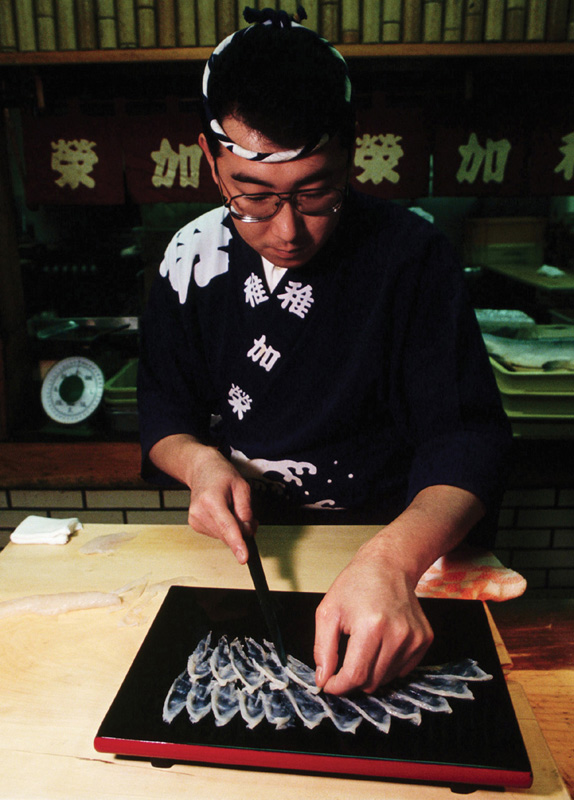
WHAT IT IS A delicacy from the deep that takes years of experience to prepare safely
WHY YOU WON’T DO IT Why we might talk about food that is ‘to die for’, do you really want to test out the theory?
Have you grown tired of beans on toast? Do you feel ready for a new culinary adventure? Then look no further than the puffer fish or fugu. This toxic little sea monster is found in tropical seas around the world, and if carelessly prepared, could leave you facing a long and painful death.
Belonging to the family of fish known as Tetraodontidae, the puffer fish’s Japanese name literally translates as ‘river pig’. With a name like that, as you might guess, it’s not much to look at. But its aesthetics are the least of your problems. What you really have to be worried about is the high levels of the poison tetrodotoxin it contains – enough to see off 30 adult humans. So maybe you should consider whether you really need to try puffer fish? A nice bit of smoked salmon or dover sole can fill an empty belly just as well.
But if you’re still game, you will probably want to eat the fish in its spiritual homeland of Japan. Here, it has been considered a delicacy for more than two millennia. It is also popular in South Korea, but cannot be sold legally in the European Union. Some 17 restaurants across the United States have a legal certificate allowing them to serve it, of which 12 are in New York.
The fish can be served in several different forms. In the classic dish sashimi, it is sliced so thinly that it becomes translucent. Otherwise you might have it deep-fried, in a salad or a stew. The fins can also be baked, while some cooks claim that the roe (egg mass) is most tasty. Do not consider trying to cook the fish yourself. It must be prepared by trained professionals. Eager amateurs have a strong chance of killing themselves, partly because the poison is not affected by the heating process – the toxic areas of the fish must be physically cut out.
In Japan, chefs have been required to have a licence to sell and prepare the fish since 1958. To get their licence they must pass an exacting series of tests after completing a three-year apprenticeship. It includes a written component, a fish identification exercise and a practical cooking test, finishing with a tasting. Chefs must be able to identify and cleanly remove organs, eyes and other poisonous parts. Worryingly, the pass rate is just 35 per cent – though fortunately most of the other 65 per cent seem to flunk on the written or preparation parts rather than during the tasting.
If you’re worried that you might have been poisoned, there are some early symptoms to be aware of. These include tingling lips and tongue. You might also feel headachy, nauseous, tired, dizzy and short of breath. Tetrodotoxin attacks the nervous system and can cause paralysis. However, it does not directly affect the brain, so those afflicted can suffer an agonizing physical shut-down, remaining conscious but unable to communicate. In a worst case scenario, the victim will die as a result of asphyxiation.
There is no known antidote to counter the poison. However, treatment includes emptying the patient’s stomach, giving him or her activated charcoal to try to neutralize the toxin, and putting them on a life support machine until the poison dissipates.
A decade-long study of poisonings in Japan up to 2006 recorded an average of 20–44 cases per year. About 7 per cent of those resulted in fatalities. The Torafugu (tiger blowfish) is the most prized and most poisonous of all the puffer fish species, with a particularly toxic liver. In 1975, one of Japan’s most beloved actors, Bandō Mitsugorō VIII, died after reputedly consuming an excessive quantity of puffer liver. By 1984, it became illegal to serve the liver even in Japan.
For those not sure they’re prepared to risk their lives for the sake of a fish supper, there is some hope. Some academics believe that the tetrodotoxin is produced by the puffer fish’s digestive system, so attempts to artifically produce a non-poisonous (but equally delicious) breed of puffer fish through carefully regulated food intake are currently underway.
FISH DISH The puffer fish might not be the most attractive of dining companions, but it is among the most highly prized. There are some 120 species of puffer, almost exclusively found in the tropics and usually in inshore waters. In the previous picture, a highly trained chef can be seen carefully preparing a fugu for the plate.